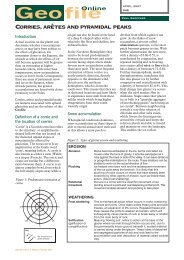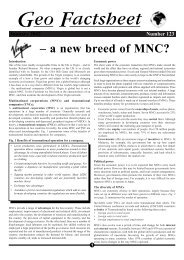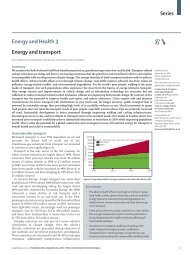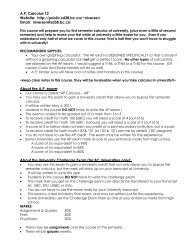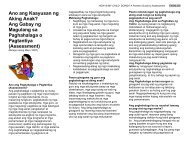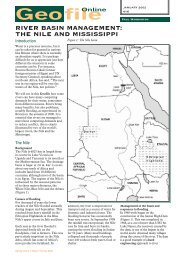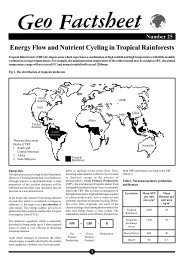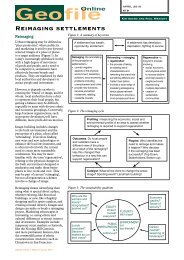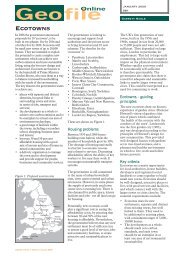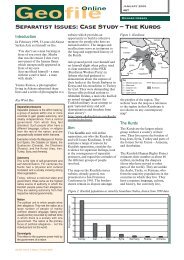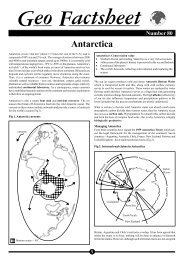191 Soil Degradation.pdf - Richmond School District No. 38
191 Soil Degradation.pdf - Richmond School District No. 38
191 Soil Degradation.pdf - Richmond School District No. 38
Create successful ePaper yourself
Turn your PDF publications into a flip-book with our unique Google optimized e-Paper software.
<strong>Soil</strong> degradation – a creeping concern<br />
Geo Factsheet<br />
Fig. 2 Types and causes of land degradation.<br />
Types of land degradation<br />
Water and wind erosion account for more than 80% of<br />
the 20 million km 2 degraded worldwide.<br />
Chemical<br />
degradation<br />
12%<br />
Wind<br />
erosion<br />
28%<br />
Physical degradation<br />
4%<br />
Water<br />
erosion<br />
56%<br />
Causes of land degradation<br />
Overgrazing and agricultural mismanagement affect more<br />
than 12 million km 2 worldwide. 20% of the world’s pasture<br />
and rangelands have been damaged and the situation is<br />
most severe in Africa and Asia. Huge areas of forest are<br />
cleared for logging, fuelwood, farming or other human uses.<br />
Industry & urbanisation<br />
1%<br />
Agricultural<br />
mismanagement<br />
27%<br />
Deforestation/<br />
fuelwood<br />
consumption<br />
37%<br />
Overgrazing<br />
35%<br />
<strong>Soil</strong> degradation encompasses several issues at various spatial<br />
time scales.<br />
• Water erosion accounts for nearly 60% of soil degradation.<br />
There are many types of erosion including surface-, gully-,<br />
rill- and tunnel-erosion.<br />
• Wind erosion<br />
• Acidification is the change in the chemical composition of the<br />
soil, which may trigger the circulation of toxic metals.<br />
• Groundwater over-abstraction may lead to dry soils, leading<br />
to physical degradation.<br />
• Salt affected soils are typically found in marine-derived<br />
sediments, coastal locations and hot arid areas where capillary<br />
action brings salts to the upper part of the soil. <strong>Soil</strong> salinity has<br />
been a major problem in Australia following the removal of<br />
vegetation in dryland farming.<br />
• Atmospheric deposition of heavy metals and persistent<br />
organic pollutants may make soils less suitable to sustain the<br />
original land cover and land use.<br />
• Climate change will probably intensify the problem. Climate<br />
change is likely to affect hydrology and hence land use.<br />
Climate change, leading to higher average temperature and<br />
changing precipitation patterns, may have three direct impacts on<br />
soil conditions:<br />
• The higher temperatures cause higher decomposition rates of<br />
organic matter. <strong>Soil</strong> organic matter is important as a source of<br />
nutrients and it improves moisture storage.<br />
• More floods will cause more water erosion.<br />
• More droughts will cause more wind erosion.<br />
Human activities<br />
Human activities have often led to degradation of 15% of the<br />
world’s land resources (Table 2). These impacts frequently lead to<br />
reduction in yields. Land conservation and rehabilitation are<br />
essential parts of sustainable agricultural development. While<br />
severely degraded soil is found in most regions of the world, the<br />
negative economic impact of degraded soil may be most severe in<br />
the countries most dependent on agriculture for their incomes.<br />
Table 2 Human activities and their impact on soil<br />
erosion.<br />
Action<br />
Removal of<br />
woodland or<br />
ploughing<br />
established pasture<br />
Cultivation<br />
Grazing<br />
Road or tracks<br />
Mining<br />
Effect<br />
The vegetation cover is removed, roots<br />
binding the soil die and the soil is<br />
exposed to wind and water. Particularly<br />
susceptible to erosion if on slopes.<br />
Exposure of bare soil surface before<br />
planting and after harvesting. Cultivation<br />
on slopes can generate large amounts<br />
of runoff and create rills and gullies.<br />
Overgrazing can severely reduce the<br />
vegetation cover and leave surface<br />
vulnerable to erosion. Grouping of<br />
animals can lead to over-trampling and<br />
creation of bare patches. Dry regions are<br />
particularly susceptible to wind erosion.<br />
Collect water due to reduced infiltration<br />
that can cause rills and gullies to form,<br />
e.g. when the west coast highway was<br />
built in St. Lucia, Tropical Storm Debbie<br />
led to massive erosion as water was<br />
channelled along exposed, bare road.<br />
Exposure of the bare soil. <strong>Degradation</strong><br />
from chemical dumping.<br />
2



